Creek Chub Bait Company Family History
Creek Chub Bait Company Family History
The information used for this Creek Chub Bait Co. History webpage was generously supplied to me by Anita Rolfe. Anita's maiden name is Anita Dills, the daughter of Gordon S. Dills and her grandfather was Henry S. Dills one of the original founder of the Creek Chub Bait Co. After Henry's death in 1927 Gordon S. Dills became vice president. When George Schulthess died in 1945 Gordon Dills became the next president of the company. Gordon S. Dills had four children, Gordon, Betty, Jean and Anita. After Anita's mother passed away Gordon re-married and she bore him a son named Richard which made 5 children. Anita was brought up on water, fishing and worked in the Creek Chub Factory during the summers of her college years. Anita, the Heinzerling and the Schulthess girls were great friends and spent many teenage years together. Anita now resides in Mansfield, Mo. and still communicates with her long time friends a few times each year.
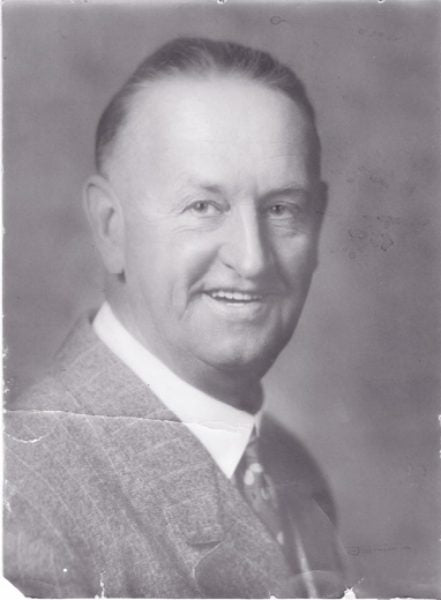
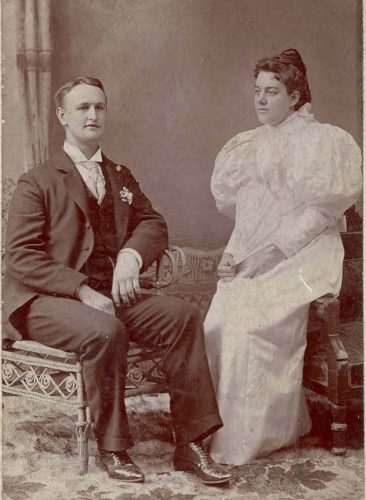
Henry S. & Minnie Dills Taken on their Wedding Day

This picture of Gordon S. Dills was taken at Anita's wedding. Anita married Henry G. Thill of St. Louis, Missouri in June of 1952. The wedding took place in Garrett, Indiana.


Anita Rolfe & son Ted Thill at Bass Pro Shops in Springfield, Missouri 2004

Anita Rolfe & son Ted Thill in front of a large bear display at Bass Pro Shops in their Creek Chub Bait Co. T-shirts.
Follow this link for some hidden history of a Dills family member. This bit of history has not been revealed in collector books or anywhere on the internet. Anita supplied me with this Biographical Sketch of George W. Gordon. I do not have the complete relationship of G.W. Gordon but we do know he was a family member of Gordon S. Dills. Anita remember that the men on her father's side always used "Sir" names and they were Scotch/Irish. Click on this link for this amazing personal history of G.W. Gordon.


Bathtub Outgrown
As some of us remember, the pace was slower in the 1914-15. Even so, Mr. Henry Dills of Garrett secretly worried that her husband --in the idiom of the age-- was harboring bats in his belfry.
Wit a good job with the B&O Railroad -- spending his waking hours whittling out odd objects which he swished through the water in the family bathtub. He sat on a chair next to the tub, carefully studying the movements of the plump torpedo.
If Henry Dills wasn't bathtub watching he might be down at the B&O cinder pit drawing his whittled object d'art through the slimy water. To compound the mystery, a couple of his cronies--also steady, family men--solemnly watched and made notes.
It was not unusual for Dills to mount his bicycle on his days off and ride to Indian Lake, Bixler at Kendallville or Sylvan at Rome City to give his plaything a test. He always returned with bass and more ideas.
As fishermen guessed in the first paragraph, that was the start of the Creek Chub Bait Co., of Garrett, one of the pioneer casting plug firms in the nation. There are a couple which are older, but note is better known over the world for the fish-taking proclivities of their products.
Much correspondence proceeded the actual forming of the company in 1916. That was the time that two of the cinder pit cronies, G. M. Schulthess, mayor of Garrett, and C. H. Heinzerling, hardware and sporting goods merchant, teamed up with Dills and went into business.
Schulthess became president, Dills vice president, and Heinzerling, secretary-treasurer. Today the founder are gone, and the second generations id carrying on. Gordon Dills is president, Howard Schulthess vice president, and Harry Heinzerling, secretary-treasures and advertising manger.
There had been artificial plugs prior to Creek Chubs. Most of them were rather unimaginative. To be sure, there have been spoons spinners and flies, too, for centuries, but the credit for imparting a natural wiggle to a piece of wood is claimed by Cree Chub.
The patented meta mouthpiece was the father of the wiggle that raised piscatorial ????? the first bait to come out with natural fish coloration and simulated scales. Success was not immediate. The men who staked their capital and reputations in with many regarded as a frivolous venture discovered there were prophets without honor in their own county. The artificial plug was quicker to catch on in distance places than with their own neighboring fishermen.
That was 40 years ago. The firm now makes and sells between a million and two million plugs each year. Their flies are full of unsolicited testimonials from celebrities in all walks of life.
Herbert Hoover, a thorough angler whether he wore a high collar or not, wrote notes of praise before, during and after he was President. Lady Beaverbrook cabled to be sure her Pikies were delivered in time at Jamaica.
There's an interesting story back of those famous Pikie plugs. A Minnesota man sent the founding Dills a bottle of pike minnows pickled in alcohol. "Imitate this fish," he said, "and you'll have a killer." Dills went to work. Between 1921 and 1950 the firm had sold over 23 million Pikies, exclusive of the jointed Pikie, which came later.
When Ivar Kreuger, late Swedish match king, died, six dozen Pikies were among his effects. Bert Lahr wrote to say he had driven 150 mile to buy a pikie, and in 1848 Harry Truman, in a rear-platform talk at Garrett, said he knew Garret produced better bait than his opponents. Two years ago in Leech lake, Minn., muskies went on a rampage and Pikies were renting at 85 per hour!
A noted industrialist--a non-fisherman-- was presented a two-footling display model Pikie as a joke. He took it fishing in Canada and later wrote a huffy letter. said he could catch nothing larger that 10 inches on the blasted thing.
A Creek Chub bait holds the world record for large-mouth bass --a 22 pound, eight ouncer, caught in Georgia in 1923. The wife of the Creek Chub representative on the East Coast, Joan Albrecht, caught the world's record striped bass too. She reluctantly admitted she was using a competitor's bait.
Creek Chub today puts out 500 types of lures and finishes. There are many old standards such as the plunker, darter, dingbat, wigglefish, injured minnow, etc. The new Pikie is making a name for itself with fishermen. It became the first all plastic Creek Chub lure. Plastics are gradually winning over red cedar in all patterns.
"Unquote from Garrett Clipper"
SOME MEMORIES OF THE CREEK CHUB BAIT COMPANY
By Gordon A. Dills

In the 1920's Sam Davenport of Auburn, Indiana was hired as sales manager. With Sam, the policy was adopted to sell to legitimate jobber only, a policy which remained in effect until the end. A few large retailers were sold direct but always at a lower discount. Several years after WWII so-called wagon jobbers were sold. Sam would make one trip a year and would obtain enough business for a year. Sam retired in 1951.
Austin (Toad) Van Houten took over the job of sales manager in 1951 and left the job two years later to return to production. Harry Heinzerling then became active in the business and took over that position until the business was sold.
Under Sam, Austin and Harry manufacturer representatives were contracted throughout the years. Ralph Beard serviced the west coast. Phil Drawson, Ellis Kinney and Tom Hambrick covered the south. Van Houten covered the East and Midwest until he went back into production at which time George Albrecht was contracted for the east. I covered the Midwest until I left the company in 1953. Finally Mack Shreve took over Indiana, Michigan, Illinois, Ohio and Louisville, Kentucky. I cannot recall who covered Texas, Arkansas and that area.
The majority of the popular lures were developed in the 30's including the Pikie Minnow, Jointed Pikie, Plunker, Darter and the Injured Minnow (flat side). Numerous other lures were developed through the years but these remained popular through the years. My father developed the Beetle and I was responsible for the Deepster and the Spoontail. Some were designed by fishermen who sent samples to the factory. One other popular bait of the 30's was the Ding Bat and Surface Ding Bat. More on that later.
The first plant was located at the corner of Cowen and Keyser Streets in Garrett-the present location of the federal post office. In then moved to 101 Keyser Street where it remained until closing.
At the conclusion of WWII production was so far behind orders a new corporation was formed called Lures Inc. It had the same officers as Creek Chub and was owned by Creek Chub. Its first factory was located in Ashley, Indiana about 20 miles north of Garrett. At the time it opened it was over one million pieces behind on the 3/4 oz. Pikie. I managed the Lures plant for several years before going into sales in Garrett. Van Houten took over at the time and managed it until his death in the late 50's land was purchased in Garrett and a Quonset hut constructed. Lures remained there until it was sold.
Both the old Lures Plant in Ashley and the Creek Chub plant in Garrett have been razed. The Lures Garrett plant was sold to a tool and die company. The plant in Garrett was donated to the city of Garrett and is now a parking lot.
With the opening of the Ashley plant wood bodies were turned there. Prior to that time turnings were made by Jim Shreve of Garrett or Harry Rosenberry of Syracuse, Indiana. Northern white cedar was purchased in Northern Michigan in slabs of various thicknesses, trucked to Ashley, cut in four foot lengths and proper sized squares. Before being turned on hand operated lathes it was kiln dried for about two weeks. Each raw body was hand sanded and dipped in a clear lacquer sealer. Four coats of white lacquer was applied followed by another cost of a clear sealer. The bodies were then sawed, drilled and punched as needed and given a final clear sealer before being sent to Garrett for final painting and assembly.
At Garrett all work was by hand. Solid colors were individually hand dipped. Various colors and designs were added with a small air brush. In earlier models glass eyes were painted, cut, sorted and pounded in by hand. Hooks, mouthpieces, spinners etc. were also put in by hand. A final coat of clear gloss lacquer was then applied. Since the factory was not air conditioned on warm muggy days the final coat had to be held until cooler drier weather because of the tendency of lacquer to blush. In all each piece received 12 to 15 coats.
Before the war private brand lures were made for both Sears and Montgomery Ward. As a boy, during the depression, I can remember the factory working two shifts. People who were not working had time to fish and it was food on the table.
In the early 50's Creek Chub began manufacturing lures for the Shakespeare Company. After several years we bought out the line of bait. The only lure kept in our line was the old Shakespeare Mouse.
Since the cost of producing wood baits was so high and with the advent of spinning after the war it was decided to produce plastic lures. The first were 1/4 oz. scaled down versions of the straight Pikie, Jointed Pikie, Plunker, Darter and Injured Minnow. A short time later almost all of the line was available in plastic including a 1/8 oz. version of the above. At that time the Pikie became available in sizes from 3 1/2 oz. to 1/8 oz.
When George Albrecht took over as the east coast representative he convinced the Board there was a need for a salt water line. The Surfster and Striper Strike were developed and became an important part of the line.
At its peak, Lures had 85 employees and Creek Chub 115. The line was shipped to all states and some 30 foreign countries.
Early on the company entered into a contract with Alcott, Laight and Westwood of Toronto to make Creek Chub baits or rather to finish their production. The white bodies as they came from Lures, the hardware were shipped to them for colors and final assembly. Boxes had stuffers were bought in Canada. At no time did CCBCo own that company. I have heard the reason AL & W was used was because in 1927 the company was so far behind in production. That does not seem logical. At the time we were making lures for Sears, etc why would we ship our own products out of the country? The reason for the above arrangement, as explained to me, was to avoid duty if shipping the completed bodies into Canada.
Much of the success of CCBCo has to be given to long time employees who spent their entire working lives at Keyser Street. Toad Van Houten started at 16, worked in production for years, became sales manager for several years and returned to production at Lures until his death. Dick Detrick also stared at sixteen and was in charge of production for years. He knew every piece of equipment, lure bodies, all the parts, exact location of saw karths and holes by heart. After the sale of the companies he stayed on with the new owners, at Lures, teaching them how. Katie Fetter, Mary Liss and Katie Liss put in hooks. Agnes Hollis put in mouth pieces. Nellie Rahmer was in charge of air brush. Katie Liss and Edith Van Houten did much of the inspecting. Edith had also worked as a sander and buffer. Alice and Lela Van Houten (sisters of Toad) worked in the fly room until that production ceased. Lela married Earl (Ding Bat) Weaver. His nickname was given to the Ding Bat series long before Archie Bunker went on TV. There were also many other faithful employees at both CCBCo and Lures.
The location of the plants was a big advantage since there were well over a hundred lakes within 45 minutes of Garrett. People from the factory tried out many of the new Lures and tested the older models. As new bait were being developed they were tested in the swimming pool at the YMCA in Auburn, Indiana where the action could readily be seen.
When I was a young boy and would go to the factory with Dad, as we walked through the office, he would point out a desk and tell me that some day I would own it because I would eventually receive 1/15th of a 1/3 of the factory. I am proud to say I did own a part of a company which made a superior product which really did catch fish.
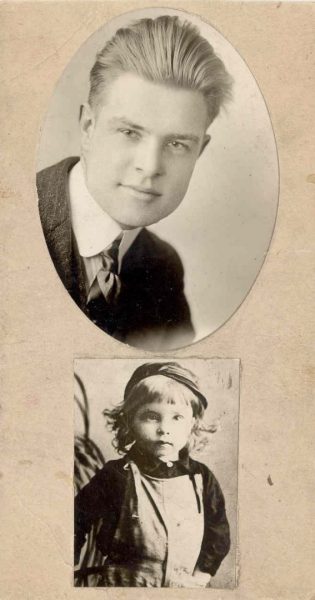
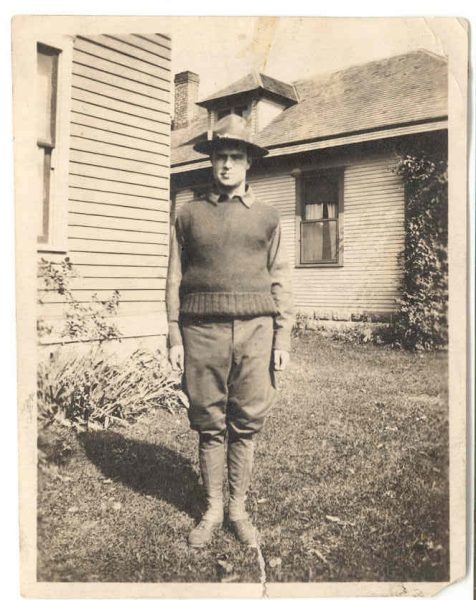

Gordon A. & Betty Dills

Gordon A. Dills in the Navy

Jean (Dills) Blue (Anita's Sister) with her dog, a Japanese Akita sometime in the late 1950's or early 1960's

Jean Dills

Don & Betty (Dills) Ritter
Cottage at Crooked Lake, Angola, Indiana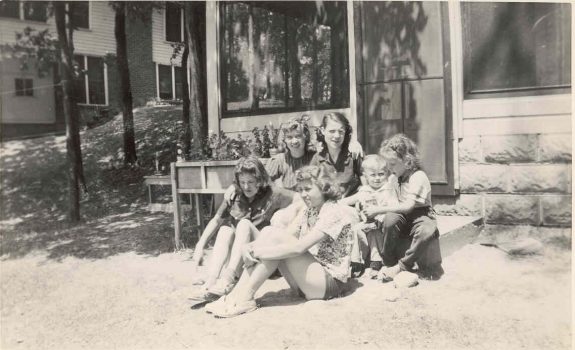
(Middle back row) - Eleanor Dills (3 girls) Eleanor's nieces (Girl with arms around boy) Anita with her little brother "Dick" Richard S. Dills

Anita & Richard (Dick) Dills
Pokagon State Park Near Crooked Lake Indiana
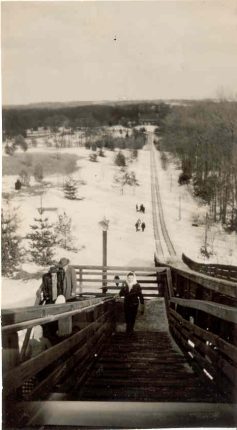
Toboggan Slide

Other End of Toboggan Slide

In front of the Hamilton cottage at Crooked Lake, Angola, Ind. in the summer of 1947: (left) Mr. Hamilton (right) Gordon Dills
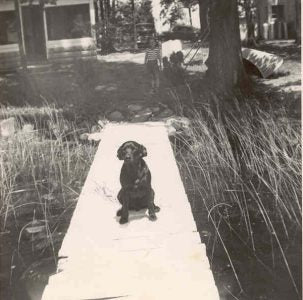
Jorchie the Favorite Family Pet at Crooked Lake
Family Memories as Remembered by Anita (Dills) Rolfe - March 2009
Anita remembers back to 1936 when she was just 3 years old. Her fist memory is of her mother, Edith Dills, when she passed away. Back in those days visitation was in the homes. Anita's Mother was laid out in the large bedroom of their house on Cowen St. in Garrett, Indiana.. She remembers someone lifting her up so she could see her mother. Anita thought to herself that she was just asleep and remembers how pretty she looked.
Anita's next memory is of Crooked Lake near Angola, Indiana. Anita loved the lake. She loved the water, the way the wind blew off the lake, the canoe & boat rides and just loved all the swimming. The Dills owned two cottages. One they would stay in all summer and the other one was rented out. The one they rented was call "The Dog House". The reason it was called such comes from a funny family story that when Anita's mother got angry with her dad he would go to the "Dog House".
Each year when the fishing season opened all her dad's friends would come up and spend the night in the Dog House. They would always bring Anita some kind of a special present and were super nice to her. Anita remembers some neat stories about these fishing excursions. One such story was that in some years before, the men would take a boat out on the lake that had a keg of beer in it and all the men would fish from boats around the boat with the beer. Anita remembers that the men would play lots & lots of poker and card games waiting to go out on the water. They would get up early dawn to fish the lake.
During the summer Anita spent hours & hours on the lake and in the winter they all went up there with "Daddy" and skated or sat in front of the fire while her dad ice fished. Anita just loved it! Gretel & Katrina Heinzerling would come along and they spent fun times on several occasions. They went to school together in Garrett, Indiana and enjoyed a wonderful childhood. Often on the way home from school they would poke there heads in the bait factory to see what was going on.
Anita's father (Gordon S. Dills) was a real outdoors man. He and his parents homesteaded land in New Mexico when he was a child. He would trap turtles on farmers ponds and at the lake in the summer. They would all eat turtle, frog legs and all kinds of fish along with wild mushrooms, strawberries, wild grapes and blueberries they would find and harvest. In the spring he would harvest the dandelion greens in the yard then clean and cook them. Also Anita remembers they always had a house dog and a hunting dog. After Anita's real mother died "Daddy" (all the children always called him daddy) married again to Eleanor L. Snyder of Ohio. She bore him a son which then made 5 children, Gordon Alan, Betty, Jean, Anita and Richard.
Gordon Alan ended up working for the Bait Company after college and serving in the Navy. Anita lived with her brother Gordon and his family in Ashley, Indiana for two summers and worked at the Ashley bait factory so she is pretty familiar with how the baits were made. The Ashley plant was located about 18 miles north of Garrett and did most of the body production, primer operations and the dip painting. The raw wood was brought in by trucks, then the wood was watered down and dried in a kiln. The wood then was sawed and turned in lathes into the proper shape for the baits. The unfinished baits were placed in large bins waiting for the next operation. A screw eye was then put in the tail end of the bait so it could be dipped and painted. Several baits were dipped at a time by hooking them onto a long pole, then dipped in a long narrow vat and hung up to dry. This was one of Anita's jobs while she worked at the factory. They were then sent off to another department for further dipping for color. The baits were then sent onto Garrett for the finishing touches. The ladies that applied the finish spray colors and "scales" were masters at their job. The scales were put on by holding a piece of screen over the bait and then sprayed. The hooks and eyes were put on next. Anita remembers watching the men that did the hooks--their fingers were heavily bandaged.
Gordon married and had 4 children, Linda, Steve, Susan and Sally. Betty married Don Ritter from Angola, Indiana. They were not successful having their own children so they adopted two children. A girl named Anita Jean and a boy named Mark. Jean married once for a short time to Bud Blue. Jean worked for Sears for many years. Anita graduated from Garrett High school in 1950 and went on to 2 years of college at Christian College, then onto Missouri University and graduating in 1954. Anita met her 1st husband, Henry (Hank) Thill while she was attending college in Columbia, Missouri. They had 3 children, Ted, Melinda and Matthew. Anita's family moved to California where her husband Hank worked for Ralston Purina. It was around 1960 when they moved back to Missouri. Hank and Anita eventually divorced and 5 years later she married Peter A. Rolfe and move to Mansfield, Missouri. This is where the famous show Little House on the Prairie was written. Peter and Anita have been married for 35 years now. Peter worked for the Chrysler Corporation until his early retirement. They both are heavily involved in the Missouri Fox Trotters. They raised and trained one of their foals "Golden Cloud" to the 1st Amateur World Grand Champion Missouri Fox Trotter in 1994. Anita has had a wonderful life!

Crooked Lake-(left) Gordon on back of women (right) Girl on back of Anita's mother, Edith Dills is a cousin

Crooked Lake-Aunt Mimmie & Edith Dills (right)

Crooked Lake-Edith Dills (left) & Aunt Maisey

This photograph was taken in January of 1962 of Anita sitting on her very 1st horse. Horseback ridding is Anita's favorite thing to do and her life long passion of horses and all animals. Today Anita has 4 horses, 8 cats and 6 dogs.

Golden Cloud - 1994 1st Amateur World Grand champion Missouri Fox Trotter
(Above) Golden Cloud won the 1st Amateur World Grand Champion Missouri Fox Trotter in 1994 when he was just 3 years old. He is a huge horse which measures 16'2 in the horse world. Anita refers to him as a gentle giant and gentle as a kitten. Anita is handling him and husband Peter Rolfe behind her. Peter & Anita trained him and they still have him today. He is their 2nd foal out of their Foundation mare Zane's Esther Bunny who gave them 3 beautiful horses.

A Dills Family Picture at Crooked Lake, Indiana
Standing in back row - (left) Anita Dills - (center) Don Ritter, future husband to Betty - (right) Betty Dills. Seated - (left) 2nd Wife, Eleanor Dills (center) Jean Dills - (right) Dick Dills. On Ground - (left) "Daddy" Gordon S. Dills - (right) Gordon A. Dills

Gordon S. Dills-Gordon always smoked Long Fellow cigarettes - Anita remembers all the children teased "Daddy" about it! Today Anita still has a Longfellow cigarette box on a shelf in their family room

The Dills Home in 1957-Garrett, Indiana
 This was placed on the site where the C.C.B.Co. was located in Garrett, Indiana when the factory was taken down.
This was placed on the site where the C.C.B.Co. was located in Garrett, Indiana when the factory was taken down.

A Special Thanks and Gratitude to Anita Rolfe for Sharing Her Famous Family History.
My Bait Shop Updates:
If you have any further information on any of the items displayed on this page which you'd like to share, please send your comments to me and I'll update the page accordingly. Contributions of interesting items and/or unknowns are encouraged.
© 2024, My Bait Shop, LLC

